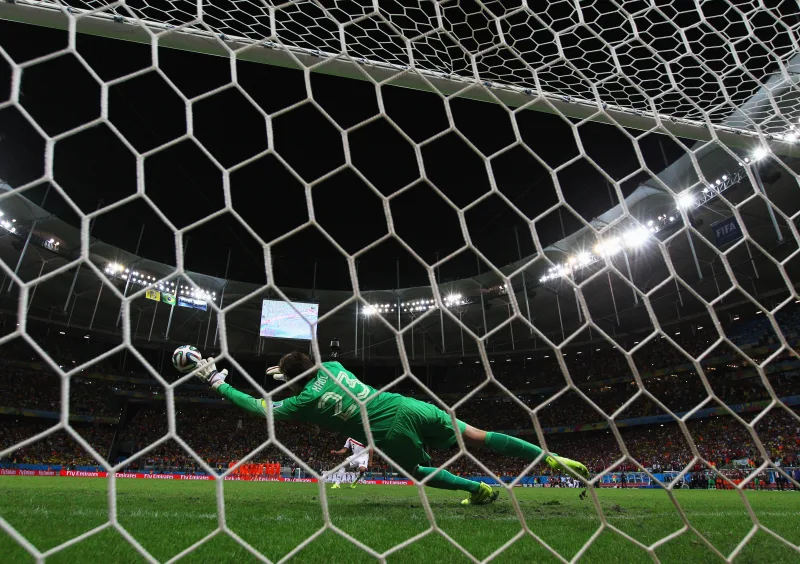Rules galore seem to only increase the chances of penalties being scored - in a situation already skewed against the goalkeeper.
In an era of VAR and an abundance of confusing laws, penalties are more complicated than ever. The awarding of penalties has come under consistent criticism in recent years, especially around the specifics of the handball rule.
For goalkeepers, penalties have always been heavily stacked against them. The average save rate in the Premier League is only around 18% according to Goalkeeper.com ‘xG’, a number similar across all of Europe's top divisions.
Spot kicks have never been more difficult for goalkeepers to keep out due to the restrictions imposed on them and the leniency afforded to the penalty takers.
Specifically, the 2024/25 IFAB Laws of the Game state that there is only one main restriction on penalty takers. That is “Feinting to kick the ball once the kicker has completed the run-up (feinting in the run-up is permitted)." In the same handbook, feinting is outlined as “An action which attempts to confuse an opponent. The Laws define permitted and ‘illegal’ feinting.”
That means, players are allowed to stutter as much as they like before taking the penalty, but they can’t “feint” once they have reached the ball at the end of their run-up. As a result, the stutter run-up has become increasingly popular, especially at Euro 2024.
In fact, Nick Miller of The Athletic wrote an article ahead of the semi-finals, stating that of the 36 penalties taken at the tournament (shootouts included), 13 of those saw the taker use a stutter run-up.
Ten of these 13 spot kicks have been scored, and one of the misses was Robert Lewandowski’s first penalty against France. The Polish striker was forced to retake this penalty because Mike Maignan was deemed to be off his line. When the penalty was taken, the French goalkeeper didn’t have a foot on the line, which is illegal under the current rules.
The rules state, “The defending goalkeeper must remain on the goal line, facing the kicker, between the goalposts, until the ball is kicked.” Lewandowski scored the retake by following the same stutter run-up routine to slot the ball home.
The advantage of this technique is that players can wait for the goalkeeper to fully commit themselves to one side, ensuring that they can slot it in the other. When the taker approaches the ball without ‘feinting’, it is much easier for the shot stopper to dive at the right time without leaving the exposed part of the goal wide open for the penalty taker.
A study of Cristiano Ronaldo’s penalty technique at Euro 2024 highlights the advantages of a stutter run-up compared to a so-called normal run-up. In the Round of 16 match against Slovenia, Portugal’s talisman missed a penalty in extra-time using a normal run-up.
He took a few steps in a continuous motion before sending the ball to the keeper’s left-hand side, which saw Atletico Madrid’s Jan Oblak able to anticipate and turn it behind for a corner.
The game went to a penalty shootout, and as Portugal’s first taker, Ronaldo stepped up again. This time, he reverted to the feinting approach and calmly slotted the ball into the bottom left corner.
In the quarter-final shootout against France, Ronaldo went for the stutter run-up again, coming extremely close to stopping entirely before sending the ball into the bottom corner.
It hasn’t been entirely successful, though, with his teammate Joao Felix missing the decisive penalty against France using the same run-up before striking the ball against the post.
Other restrictions on goalkeepers provide the taker with an additional advantage. The rules also state that “The goalkeeper must not behave in a way that unfairly distracts the kicker, e.g. delay the taking of the kick or touch the goalposts, crossbar or goal net.”
This rule was first announced in March 2023, a few months after the 2022 World Cup in Qatar. Emiliano Martinez’ distraction tactics in the World Cup final were on display, such as throwing the ball away from the French takers as they approached the spot.
In this instance, Martinez was extremely successful, saving two penalties as Argentina became world champions. However, Martinez-like antics are no longer permitted according to IFAB’s strict rules.
The laws also now clearly state that keepers are not allowed to touch the net, goalposts, or crossbar to try and affect the penalty taker.
Australia’s Andrew Redmayne used these distraction tactics during a World Cup qualifying match against Peru. Nicknamed the ‘Grey Wiggle’, Redmayne was seen jumping around on his line and waving his arms around before saving the fifth Peru penalty to send the Socceroos to the 2022 World Cup. According to the new laws, this would be punished by the officials.
Following the announcement of these rules, Australia goalkeeping coach John Crawley told the Sydney Morning Herald, "What more can we do? Are we just going to stand there and let them score?
"I just think, on the whole, the goalkeeping community, we don't get a lot. And now this is a bit of a kick in the face. It's farcical, to be fair, and a strange amendment they've come up with.
"We're at a disadvantage to begin with at penalties. Any type of edge that the goalkeeper can get in a penalty shootout, you're still at a disadvantage, but that edge makes it a little bit more even.
"I just think, if they take that away from us, we might as well have a penalty and not have a goalkeeper."
A thorough inspection of the current rules surrounding penalties therefore paints a very clear picture. Goalkeepers are now heavily restricted, while the taker has much more freedom at his or her disposal.








